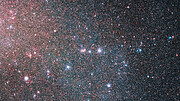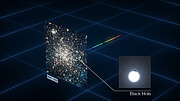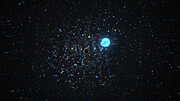Using the European Southern Observatory’s Very Large Telescope (ESO’s VLT), astronomers have discovered a small black hole outside the Milky Way by looking at how it influences the motion of a star in its close vicinity. This is the first time this detection method has been used to reveal the presence of a black hole outside of our galaxy. The method could be key to unveiling hidden black holes in the Milky Way and nearby galaxies, and to help shed light on how these mysterious objects form and evolve.
The newly found black hole was spotted lurking in NGC 1850, a cluster of thousands of stars roughly 160 000 light-years away in the Large Magellanic Cloud, a neighbour galaxy of the Milky Way.
“Similar to Sherlock Holmes tracking down a criminal gang from their missteps, we are looking at every single star in this cluster with a magnifying glass in one hand trying to find some evidence for the presence of black holes but without seeing them directly,” says Sara Saracino from the Astrophysics Research Institute of Liverpool John Moores University in the UK, who led the research now accepted for publication in Monthly Notices of the Royal Astronomical Society. “The result shown here represents just one of the wanted criminals, but when you have found one, you are well on your way to discovering many others, in different clusters.”
This first “criminal” tracked down by the team turned out to be roughly 11 times as massive as our Sun. The smoking gun that put the astronomers on the trail of this black hole was its gravitational influence on the five-solar-mass star orbiting it.
Astronomers have previously spotted such small, “stellar-mass” black holes in other galaxies by picking up the X-ray glow emitted as they swallow matter, or from the gravitational waves generated as black holes collide with one another or with neutron stars.
However, most stellar-mass black holes don’t give away their presence through X-rays or gravitational waves. “The vast majority can only be unveiled dynamically,” says Stefan Dreizler, a team member based at the University of Göttingen in Germany. “When they form a system with a star, they will affect its motion in a subtle but detectable way, so we can find them with sophisticated instruments.”
This dynamical method used by Saracino and her team could allow astronomers to find many more black holes and help unlock their mysteries. “Every single detection we make will be important for our future understanding of stellar clusters and the black holes in them,” says study co-author Mark Gieles from the University of Barcelona, Spain.
The detection in NGC 1850 marks the first time a black hole has been found in a young cluster of stars (the cluster is only around 100 million years old, a blink of an eye on astronomical scales). Using their dynamical method in similar star clusters could unveil even more young black holes and shed new light on how they evolve. By comparing them with larger, more mature black holes in older clusters, astronomers would be able to understand how these objects grow by feeding on stars or merging with other black holes. Furthermore, charting the demographics of black holes in star clusters improves our understanding of the origin of gravitational wave sources.
To carry out their search, the team used data collected over two years with the Multi Unit Spectroscopic Explorer (MUSE) mounted at ESO’s VLT, located in the Chilean Atacama Desert. “MUSE allowed us to observe very crowded areas, like the innermost regions of stellar clusters, analysing the light of every single star in the vicinity. The net result is information about thousands of stars in one shot, at least 10 times more than with any other instrument,” says co-author Sebastian Kamann, a long-time MUSE expert based at Liverpool’s Astrophysics Research Institute. This allowed the team to spot the odd star out whose peculiar motion signalled the presence of the black hole. Data from the University of Warsaw’s Optical Gravitational Lensing Experiment and from the NASA/ESA Hubble Space Telescope enabled them to measure the mass of the black hole and confirm their findings.
ESO’s Extremely Large Telescope in Chile, set to start operating later this decade, will allow astronomers to find even more hidden black holes. “The ELT will definitely revolutionise this field,” says Saracino. “It will allow us to observe stars considerably fainter in the same field of view, as well as to look for black holes in globular clusters located at much greater distances.”
More information
This research was presented in a paper to appear in Monthly Notices of the Royal Astronomical Society (https://doi.org/10.1093/mnras/stab3159).
The team is composed of S. Saracino (Astrophysics Research Institute, Liverpool John Moores University, UK [LJMU]), S. Kamann (LJMU), M. G. Guarcello (Osservatorio Astronomico di Palermo, Palermo, Italy), C. Usher (Department of Astronomy, Oskar Klein Centre, Stockholm University, Stockholm, Sweden), N. Bastian (Donostia International Physics Center, Donostia-San Sebastián, Spain, Basque Foundation for Science, Bilbao, Spain & LJMU), I. Cabrera-Ziri (Astronomisches Rechen-Institut, Zentrum für Astronomie der Universität Heidelberg, Heidelberg, Germany), M. Gieles (ICREA, Barcelona, Spain and Institut de Ciències del Cosmos, Universitat de Barcelona, Barcelona, Spain), S. Dreizler (Institute for Astrophysics, University of Göttingen, Göttingen, Germany [GAUG]), G. S. Da Costa (Research School of Astronomy and Astrophysics, Australian National University, Canberra, Australia), T.-O. Husser (GAUG) and V. Hénault-Brunet (Department of Astronomy and Physics, Saint Mary’s University, Halifax, Canada).
The European Southern Observatory (ESO) enables scientists
worldwide to discover the secrets of the Universe for the benefit of
all. We design, build and operate world-class observatories on the
ground — which astronomers use to tackle exciting questions and spread
the fascination of astronomy — and promote international collaboration
in astronomy. Established as an intergovernmental organisation in 1962,
today ESO is supported by 16 Member States (Austria, Belgium, the Czech
Republic, Denmark, France, Finland, Germany, Ireland, Italy, the
Netherlands, Poland, Portugal, Spain, Sweden, Switzerland and the United
Kingdom), along with the host state of Chile and with Australia as a
Strategic Partner. ESO’s headquarters and its visitor centre and
planetarium, the ESO Supernova, are located close to Munich in Germany,
while the Chilean Atacama Desert, a marvellous place with unique
conditions to observe the sky, hosts our telescopes. ESO operates three
observing sites: La Silla, Paranal and Chajnantor. At Paranal, ESO
operates the Very Large Telescope and its Very Large Telescope
Interferometer, as well as two survey telescopes, VISTA working in the
infrared and the visible-light VLT Survey Telescope. Also at Paranal ESO
will host and operate the Cherenkov Telescope Array South, the world’s
largest and most sensitive gamma-ray observatory. Together with
international partners, ESO operates APEX and ALMA on Chajnantor, two
facilities that observe the skies in the millimetre and submillimetre
range. At Cerro Armazones, near Paranal, we are building “the world’s
biggest eye on the sky” — ESO’s Extremely Large Telescope. From our
offices in Santiago, Chile we support our operations in the country and
engage with Chilean partners and society.
Links
- Research paper
- Photos of the VLT
- Find out more about ESO's Extremely Large Telescope
- For journalists: subscribe to receive our releases under embargo in your language
- For scientists: got a story? Pitch your research
Contacts:
Sara Saracino
Astrophysics Research Institute, Liverpool John Moores University
Liverpool, United Kingdom
Email: S.Saracino@ljmu.ac.uk
Sebastian Kamann
Astrophysics Research Institute, Liverpool John Moores University
Liverpool, United Kingdom
Email: S.Kamann@ljmu.ac.uk
Stefan Dreizler
Institute for Astrophysics, University of Göttingen
Göttingen, Germany
Email: dreizler@astro.physik.uni-goettingen.de
Mark Gieles
ICREA, Barcelona, Spain and Institut de Ciències del Cosmos, Universitat de Barcelona
Barcelona, Spain
Email: mgieles@icc.ub.edu
Bárbara Ferreira
ESO Media Manager
Garching bei München, Germany
Tel: +49 89 3200 6670
Cell: +49 151 241 664 00
Email: press@eso.org
Source: ESO/News







